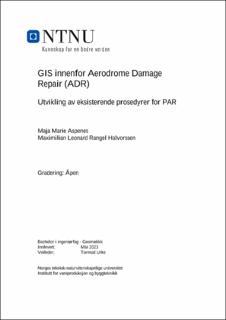| dc.contributor.advisor | Urke, Tormod | |
| dc.contributor.advisor | Bjerke, Halvard | |
| dc.contributor.advisor | Svinsås, Eirik | |
| dc.contributor.author | Aspenes, Maja Marie | |
| dc.contributor.author | Halvorssen, Maximilian Leonard Rangel | |
| dc.date.accessioned | 2023-07-01T17:33:54Z | |
| dc.date.available | 2023-07-01T17:33:54Z | |
| dc.date.issued | 2023 | |
| dc.identifier | no.ntnu:inspera:139559858:148949057 | |
| dc.identifier.uri | https://hdl.handle.net/11250/3075227 | |
| dc.description.abstract | En operativ rullebane fri for fremmedobjekter og skader er essensielt for å sikre at fly kan ta av og lande trygt, og legger grunnlaget for at Luftforsvaret kan gjennomføre sine operasjoner i lufta. Fagfeltet Aerodrome Damage Repair (ADR) skal sikre at en flystasjon raskt blir operativ igjen etter et angrep gjennom å rekognosere skadeomfanget og reparere skadene effektivt. Likevel består i hovedsak flere av prosedyrene innenfor ADR av lite teknologiske systemer. Denne oppgaven ønsker å konstruere et GIS-verktøy som skal håndtere informasjon fra rekognoseringen av en rullebane for å utvikle ADR-prosessen, og samtidig redusere risikoen for personellet underveis i arbeidet. Verktøyet skal være brukervennlig og bidra til situasjonsforståelse for alt personell på flystasjonen, og utvikles med fokus på strukturering, innhenting, analyse og distribusjon av informasjon.
Verktøyet ble utviklet i ArcGIS Online, en skybasert plattform for geografisk informasjon med kjerne i et webkart som kommuniserer med flere ulike tilleggsapplikasjoner. Strukturen i verktøyet er basert på en mal for innmelding av funn. Denne strukturen er videre benyttet for innrapportering gjennom Field Maps-applikasjonen. Bruken av denne mobile applikasjonen bidrar også til at enheter på bakken kan se oversiktskartet med de innrapporterte funnene. De innmeldte funnene blir analysert ved hjelp av et tidsdrevet Python-skript, og analysene distribueres ut gjennom Field Maps og Dashboards til alle på flystasjonen. Gjennom utviklingen av verktøyet er det tilrettelagt for at det kan implementeres på Forsvarets plattformer ved hjelp av ArcGIS Enterprice, og videreutvikles der.
Resultatet er et verktøy som kan strukturere, innhente, analysere og distribuere data fra rekognoseringen av en rullebane, eksemplifisert gjennom en fiktiv case på Oslo Lufthavn. Verktøyet legger til rette for økt situasjonsforståelse for alt personell på flystasjonen og kan som følge av dette redusere risikoen under arbeidet med ryddig og reparasjon av rullebanen. Flere av prosessene i verktøyet er også standardiserte og automatiserte for å bidra til et mer brukervennlig verktøy. Oppgaven viser med dette at et dynamisk GIS kan bidra inn i utviklingen av de nåværende prosedyrene for PAR. | |
| dc.description.abstract | An operational runway free of foreign objects and damage is essential to ensure that aircrafts can take off and land safely. This is a foundational condition that allows the Royal Norwegian Air Force to carry out its operations in the air. The field of Aerodrome Damage Repair (ADR) is intended to ensure that an air station quickly becomes operational again after an attack by completing a reconnaissance of the extent of any damage and repairing it effectively. However, several of the procedures within ADR are mainly based on nontechnological systems. The purpose of this bachelor thesis is to develop a GIS tool that can exploit the information from the reconnaissance of a runway to make the ADR process more efficient, and at the same time reduce the risk for personnel during the repair work. The tool must be user-friendly and contribute to situational awareness, and will be developed by focusing on structuring, capturing, analyzing and distributing information.
The tool was developed using ArcGIS Online, a cloud-based software for geographic information centered around a webmap that communicates with several different additional applications. The structure of the tool is based on a standard template for reporting findings. This structure lays the foundation for the reports that are submitted using Field Maps. The use of this mobile application also helps the units on the ground to see the map containing the reported findings. The reported findings are analyzed using a time-driven Python script, and the analyzes are distributed through Field Maps and Dashboards to all the personnel at the air station. Through the development of the tool, it has been arranged so that it can be implemented on the Norwegian Armed Forces' platforms using ArcGIS Enterprise and be developed further there.
The result is a tool that can structure, capture, analyze and distribute information from PAR, exemplified through a fictional case at Oslo Airport. The tool facilitates increased situational awareness for all personnel at the air station and can, as a result of this, reduce the risk during the work on repairing the runway. It also consists of standardized and automated processes that can contribute to a more user-friendly tool. These findings show that a dynamic GIS can contribute to the development of the current procedures for PAR. | |
| dc.language | nob | |
| dc.publisher | NTNU | |
| dc.title | GIS innenfor Aerodrome Damage Repair (ADR) | |
| dc.type | Bachelor thesis | |
